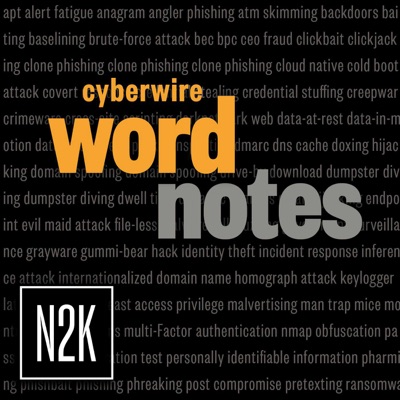Discover Word Notes
Word Notes

289 Episodes
Reverse
The resilience discipline of controlled stress test experimentation in continuous integration/continuous delivery environments, CI/CD environments, to uncover systemic weaknesses.
CyberWire Glossary link: https://thecyberwire.com/glossary/chaos-engineering
Audio reference link: Farnam Street, 2009. Richard Feynman Teaches you the Scientific Method [Website]. Farnam Street. URL https://fs.blog/mental-model-scientific-method/
Learn more about your ad choices. Visit megaphone.fm/adchoices
A mathematical method by which one party (the prover) can prove to another party (the verifier) that something is true, without revealing any information apart from the fact that this specific statement is true.
CyberWire Glossary link: https://thecyberwire.com/glossary/zero-knowledge-proof
Audio reference link: Staff, 2022. Zero Knowledge Proofs [Video]. YouTube. URL https://www.youtube.com/watch?v=5qzNe1hk0oY
Learn more about your ad choices. Visit megaphone.fm/adchoices
A U.S. law designed to improve the portability and accountability of health insurance coverage.
CyberWire Glossary link: https://thecyberwire.com/glossary/hipaa
Audio reference link: Dr. Dana Brems, 2021. Doctor reacts to “HIPAA violations” [Video]. YouTube. URL https://www.youtube.com/shorts/Ksk00s8a_IU
Learn more about your ad choices. Visit megaphone.fm/adchoices
A qualitative public framework for rating the severity of security vulnerabilities in software.
CyberWire Glossary link: https://thecyberwire.com/glossary/common-vulnerability-scoring-system
Audio reference link: Peter Silva, 2020. What is Common Vulnerability Scoring System (CVSS) [Video]. YouTube. URL https://www.youtube.com/watch?v=rR63F_lfKf0
Learn more about your ad choices. Visit megaphone.fm/adchoices
A unified security incident detection and response platform that connects to multiple tools in the security stack via APIs, collects telemetry from each, and attempts to correlate that telemetry into a coherent threat picture.
CyberWire Glossary link: https://thecyberwire.com/glossary/extended-detection-and-response
Audio reference link: Film Major. 2022. Enemy of the State (1998) Faraday Cage HD Tony Scott; Will Smith, Gene Hackman Jon Voight [Video]. YouTube. URL https://www.youtube.com/watch?v=n3gy4otg-24
Learn more about your ad choices. Visit megaphone.fm/adchoices
A cyber information-sharing U.S. Government organization designed to foster the public-private partnership.
CyberWire Glossary link: https://thecyberwire.com/glossary/joint-cyber-defense-collaborative
Audio reference link: Jen Easterly. 2021. CISA Director Addresses the National Technology Security Coalition [Video]. YouTube. URL https://www.youtube.com/watch?v=ucb1FQXqsao
Learn more about your ad choices. Visit megaphone.fm/adchoices
Tools that automate the identification and remediation of cloud misconfigurations.
CyberWire Glossary link: https://thecyberwire.com/glossary/cloud-security-posture-management
Audio reference link: Josh Whedon. 2005. Serenity [Movie]. IMDb. URL https://www.imdb.com/title/tt0379786/
Learn more about your ad choices. Visit megaphone.fm/adchoices
A session and user authentication Zero Trust tactic that allows a user to access multiple applications with one set of login credentials.
CyberWire Glossary link: https://thecyberwire.com/glossary/single-sign-on
Audio reference link: English, J., 2020. What is Single Sign-On (SSO)? SSO Benefits and Risks [Video]. YouTube. URL https://www.youtube.com/watch?v=YvHmP2WyBVY
Learn more about your ad choices. Visit megaphone.fm/adchoices
Please enjoy this encore of Word Notes.
An optional security mode for macOS and iOS that reduces the attack surface of the operating system by disabling certain commonly attacked features.
CyberWire Glossary link: https://thecyberwire.com/glossary/apple-lockdown-mode
Audio reference link: “How NSO Group’s Pegasus Spyware Was Found on Jamal Khashoggi’s Fiancée’s Phone,” FRONTLINE, YouTube, 18 July 2021.
Learn more about your ad choices. Visit megaphone.fm/adchoices
While our team is out on winter break, please enjoy this episode of Word Notes.
A security awareness training technique in which authorized, but fake phishing emails are sent to employees in order to measure and improve their resistance to real phishing attacks.
CyberWire Glossary link: https://thecyberwire.com/glossary/simulated-phishing
Audio reference link: “Blackhat (2014) - Hacking the NSA Scene (4/10) | Movieclips.” YouTube, YouTube, 19 Apr. 2017.
Learn more about your ad choices. Visit megaphone.fm/adchoices
Please enjoy this encore of Word Notes.
The process of installing applications on a device without the use of official software distribution channels.
CyberWire Glossary link: https://thecyberwire.com/glossary/sideloading
Learn more about your ad choices. Visit megaphone.fm/adchoices
Please enjoy this encore of Word Notes.
A zero trust security technique that isolates application workloads from each other, allowing each one to be protected individually.
CyberWire Glossary link: https://thecyberwire.com/glossary/microsegmentation
Audio reference link: “Micro-Segmentation Masterpieces,” PJ Kirner, Illumio CTO and Co-Founder, Tech Field Day, YouTube, 13 December 2020.
Learn more about your ad choices. Visit megaphone.fm/adchoices
An authentication process that requires two different factors before granting access.
CyberWire Glossary link: https://thecyberwire.com/glossary/two-factor-authentication
Learn more about your ad choices. Visit megaphone.fm/adchoices
A cloud based sensitive information management system that allows users access across multiple devices.
CyberWire Glossary link: https://thecyberwire.com/glossary/icloud-keychain
Audio reference link: Ellen’s Tips For iOS, 2022. How To Master iCloud Keychain to Keep Your Passwords Safe and Secure [Video]. YouTube. https://www.youtube.com/watch?v=Tl3E29iUvgE
Learn more about your ad choices. Visit megaphone.fm/adchoices
Unsolicited, unwanted, and sometimes malicious electronic messages indiscriminately transmitted to a large number of people.
CyberWire Glossary link: https://thecyberwire.com/glossary/spam
Audio reference link: zumpzump, 2007. Monty Python - Spam [Video]. YouTube. URL https://www.youtube.com/watch?v=anwy2MPT5RE.
Learn more about your ad choices. Visit megaphone.fm/adchoices
A US Department of Homeland Security agency tasked with supporting cyber and physical security for US critical infrastructure.
CyberWire Glossary link: https://thecyberwire.com/glossary/cybersecurity-and-infrastructure-security-agency
Audio reference link: CISA, 2021. CISA Director Jen Easterly’s Keynote at Black Hat USA 2021 [Video]. YouTube. URL https://www.youtube.com/watch?v=q7bu-L-m4K4.
Learn more about your ad choices. Visit megaphone.fm/adchoices
The act of searching through an organization's trash for discarded sensitive material.
CyberWire Glossary link: https://thecyberwire.com/glossary/dumpster-diving
Audio reference link: “Better Call Saul jimmy digs in the Sandpiper trash scene,” uploaded by Robert Bowersock, 18 September 2022.
Learn more about your ad choices. Visit megaphone.fm/adchoices
The manipulation of search engine optimization, SEO, to promote malicious sites in search engine results.
CyberWire Glossary link: https://thecyberwire.com/glossary/search-engine-optimization-poisoning
Audio reference link: Brown, B.E., 2021. The Ending Of The Waldo Moment Explained [Video]. YouTube. URL https://www.youtube.com/watch?v=HsWja44-EMg.
Learn more about your ad choices. Visit megaphone.fm/adchoices
The practice of crafting a fake online persona for malicious purposes.
CyberWire Glossary link: https://thecyberwire.com/glossary/catfish
Audio reference link: netbunny, 2013. Catfish - The Movie - Ending Scene [Movie Scene]. YouTube. URL https://www.youtube.com/watch?v=qR_NIN6zy0U
Learn more about your ad choices. Visit megaphone.fm/adchoices
A passwordless authentication protocol based on the FIDO2 standard.
CyberWire Glossary link: https://thecyberwire.com/glossary/passkey
Audio reference link: Summers, J., 2023. Google Passkeys Have Arrived (here’s how to use them) [All Things Secured Channel]. YouTube. URL https://www.youtube.com/watch?v=oFO7JgUx-bU.
Learn more about your ad choices. Visit megaphone.fm/adchoices




